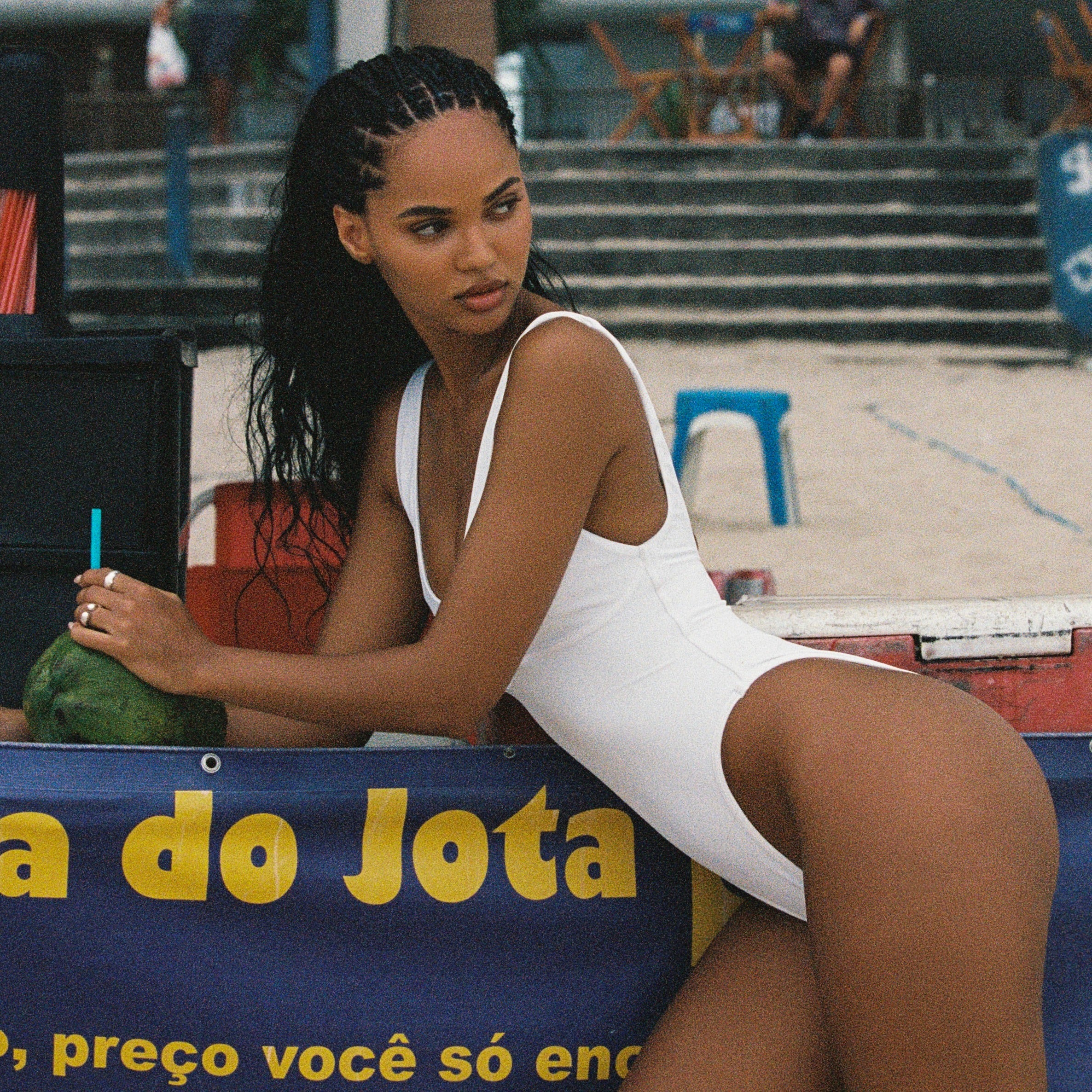Whether you’re taking a dip in the ocean or swimming laps in an Olympic-length swimming pool, you know that the right bathing suit is a necessity. After all, bathing suits are more than just our favorite fun fashion statements; they’re also functional, and when it comes to function, swim fabric makes all the difference.
That’s right, there’s a whole world of swimsuit materials to explore, and they aren’t all created equal. Naturally, you’re probably wondering about the absolute best material for swimwear. You’re in the right place. We’re deep diving into all of the most common swimsuit materials and the factors to consider to choose the best option for you.
Let’s jump right in.
Common Swimsuit Materials
The first thing you need to understand is that there are two primary fiber types:
- Natural
- Synthetic
When it comes to the best material for swimwear, we’ll only be focusing on synthetic fibers. Why? Well, would you want to go for a swim in a wool bikini? It’s true that in the days of old, bathing gowns were made from natural materials like cotton and wool, but as you can expect, these fibers absorb and hold water—not the look (or feel) you want for your tropical vacation.
As the fashion industry grows more sustainable, some designers have begun experimenting again with natural fibers like polycotton blends; however, the technology has yet to live up to consumer expectations. If you do choose swimwear made from natural fibers, plan to spend most of your day tanning and reading by the ocean rather than splashing in the waves.
For now, let’s focus on six popular synthetic materials:
- Elastane
- Nylon
- Polyester
- Polybutylene Terephthalate
- Neoprene
- Scuba Fabric
The majority of bathing suits you encounter will be made from a combination of these synthetic materials. Each has its own advantages, so let’s take a closer look.
Elastane
Elastane makes a big splash in the world of aquatic apparel, but you won’t find it on its own. Rather, it’s blended with other synthetic or even natural fibers. Maybe you can tell from its name but its elasticity makes it a favorite for swimwear designers.1
- Why we love it – Elastane’s flexibility also makes it form-fitting. Plus, its moisture-wicking abilities are ideal when you transition from sea to sun.
- What it lacks – The main drawback to elastane is that it’s usually expensive and more difficult to produce. However, this also means that when you purchase swimwear with elastane, you can feel confident that it’s a high-quality garment.
Nylon
Nylon also goes by polyamide. It’s one of the most popular synthetic swimwear materials, with the other being polyester. It’s often combined with elastane to create a swim fabric that’s both form-fitting and comfortable.1
- Why we love it – It’s known for being super soft, and it can be made with both satin and glossy finishes.2 It’s also stretchy and easy to wash.1
- What it lacks – Compared to polyester, nylon pills more and is more sensitive to sunlight. It’s also not as resistant to chlorine1 or as colorfast as polyester,2 meaning its dye might fade or wash out more readily. For fierce fashionistas, nylon has additional limitations; it's more likely to come in solid colors rather than patterns due to manufacturing difficulties.2
Polyester
Next to nylon, polyester is the other most common synthetic fabric for swimwear. But you should be aware that polyester fabric can vary significantly depending on the type used. In fact, there are hundreds of different polyester fabric blends.2
- Why we love it – Polyester is a long-lasting fabric, resistant to fading, chlorine, and sunlight—perfect for long days in the swimming pool or on a lounge chair at the beach. This makes for great versatility within a single suit. It maintains its shape well, has moisture-wicking properties, and is easy to wash.1
- What it lacks – Because there are so many different variations of polyester, its quality can vary.1 One strategy to test quality is to examine the fabric for softness and stretch.2
Polybutylene Terephthalate (PBT)
Polybutylene Terephthalate (say that ten times fast) is a polyester material commonly used in swimwear. It also goes by PBT, for less of a tongue twister. Competitive sportswear is the primary use for this fabric because of how efficiently it moves through water.1
- Why we love it – In addition to its competitive advantages, PBT is quick-drying, doesn’t fade, doesn’t pill, and is resistant to chlorine and other chemicals found in swimming pools. For regular swim team practices or solo workouts, its hard to beat.
- What it lacks – One of its main drawbacks is that PBT has less elasticity than other polyester materials.
Neoprene
Okay, neoprene isn’t technically a fabric. Rather it’s the inner layer of rubber inside wetsuits that insulates you from cold water.1
- Why we love it – Neoprene is a must for surfers and divers, especially in winter and cold waters so that they can keep warm while they enjoy their aquatic activities.
- What it lacks – Neoprene keeps you warm by trapping water, heated by your body, inside the wetsuit. But this also means that neoprene swimwear is very tight—sometimes too tight, and therefore, a bit uncomfortable.
Scuba Fabric
Quite similar to neoprene but without that additional insulation,1 scuba fabric is still a high-performing swimwear fabric.
- Why we love it – Scuba fabric is a durable material. Plus, it’s opaque, so you’ll never have to worry about unwanted attention as you step out of the water.
- What it lacks – Like neoprene, scuba fabric is tight and less elastic than more casual swimwear.
The Best Swimsuit Material for Your Needs
So now you know about some of the most popular swimwear fabrics and their associated pros and cons. To help you choose which is ultimately the best material for swimwear for you, let’s look at some more subjective factors, including:
- Style
- Opacity
- Comfort
- Durability
- Cost
- Sustainability
Style
When you’re considering the technical features of different swimwear materials, it’s easy to forget the fun of fashion. But at the end of the day, style is as important as any other consideration. You want minimalist swimwear that you feel confident in! To that end, blends with elastane are particularly helpful because of its ability to flatter every silhouette.1
Opacity
When you’re testing different swimsuit types and styles, it’s important to wet the fabric to make sure you’re in the clear (but your swimsuit’s not).1 Generally, swimwear has linings to ensure it’s never transparent.1 Common lining fabrics include:3
- Tricot
- Nylon
- Power mesh
When you try a swimsuit on, the lining should be both comfortable and flattering.
Comfort
Depending on your priorities, comfort could be the biggest non-negotiable on your list. There are several different factors to consider when it comes to comfort:
- Weight – Generally, lighter fabrics are more comfortable and look better. Luckily, it’s the industry standard to create swimwear from lightweight fabrics. Still, if something doesn’t seem right with a potential swimsuit, consider whether the fabric might be weighing you down.1
- Control – In swimwear, this refers to how much the fabric conforms to your body. Have you ever dealt with the dreaded baggy bikini bottoms? That’s why control is so important. You can test this feature by pulling on the fabric. You should feel some resistance, and it should return to its original shape when you let go. Online, look for terms such as:3
- Compression
- Firm stretch
- Recovery
- Stretch – When it comes to elasticity, you want a suit that conforms to your body without becoming restrictive. Ideally, the best fabric should have four-way stretch, allowing for freedom of movement both vertically and horizontally. Look for fabric that stretches at least 60-70%.1
- Support – Sister of stretch, support is an essential consideration for many. If you were gifted with generous curves, you’ll want features like foam cups, underwire, and elastic to make sure everything stays in place, and that you can stay in your suit for hours.
- Quick dry – Generally, synthetic fibers dry quickly, especially polyester and nylon. The fiber content of the material will affect this property. Adding elastane helps make both polyester and nylon more water-resistant.1
Durability
When you invest in a good piece of swimwear, you want it to last. That’s why durability is so important. Look for colorfast fabrics, especially if your swimwear will be exposed to sunlight and chemicals like chlorine. As a general rule, nylon fabric is more likely to fade than polyester fabrics. Because of the same fabric properties, nylon fabric is also more likely to pill than polyester suits.1
Cost
Naturally, cost will come into consideration when you’re purchasing swimwear. As we’ve covered, the different price points of each fabric can vary significantly. It’s tempting to purchase the least expensive option, but consider that your swimwear is an investment. Spend a little more for something you love—something flattering, durable, and timeless.
Sustainability
As we touched on earlier, there’s a growing trend of designers experimenting with natural fibers in swimwear in the name of sustainability. But you don’t need to don a cotton bikini to embrace the principle of sustainability. You can also avoid petroleum-based synthetic fibers or opt for fabrics made from recycled synthetic materials.1
Gooseberry: Dive into a New World of Swimwear
If there were swimsuit material Olympics, you’d be a veritable Michael Phelps with your new aquatic knowledge. Ready to find your perfect fit? Dive into a world of luxury swimwear with Gooseberry. Your next best swimsuit is just a click away.
Sources:
- Silver Bobbin. What Is the Best Swimsuit Material? https://silverbobbin.com/best-swimsuit-materials/
- Prototype. What’s the Best Swimsuit Fabric in 2022? https://prototype.fashion/best-swimsuit-fabric/
- Seamwork. How to Shop for Swimwear Fabric. https://www.seamwork.com/articles/how-to-shop-for-swimwear-fabric













